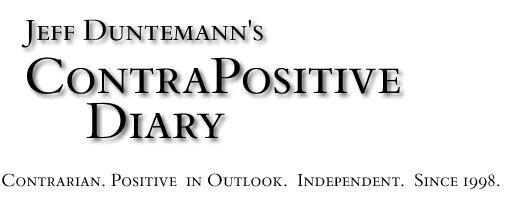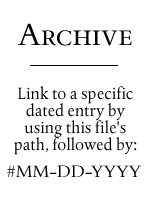|
|
|

|
 February
24, 2008: Open That Bottle Night February
24, 2008: Open That Bottle Night
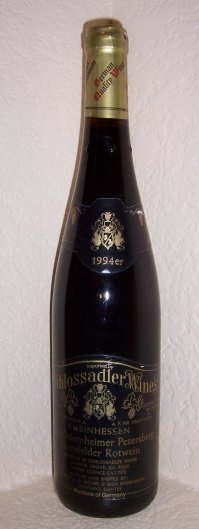 Last
night was Open
That Bottle Night, the annual event that Wall Street Journal
wine columnists John Brecher and Dorothy Gaiter created almost by
accident a few years ago. The idea is for people who have been saving
a bottle of wine with emotional or historical connections to their
lives to stop hoarding it, just open it, and enjoy it. It was a
golden opportunity for us to pull out the dusty bottle of the Schlossadler
Gau-Odernheimer Petersberg Dornfelder Rotwein 1994 that we had originally
intended to open on our 25th wedding anniversary in 2001. The bottle
has a peculiarly effective sort of self-preservation instinct: We
forgot and left it behind in Phoenix when we drove to Chicago to
celebrate our 25th in 2001. (9-11 was only a week before we left,
and other things than wine were on our minds.) We then figured we'd
open it on the 35th
anniversary of our meeting one another in July 2004, but again
we were in Chicago. The following year we figured we'd open it on
July 31, for the 36th anniversary of our meeting, but
were famously foiled by my flop into a patch of poison ivy.
We then figured we'd open it for our 30th wedding anniversary in
2006, but by that time the bottle had gotten so far back in our
memories that we clean fergot. Last
night was Open
That Bottle Night, the annual event that Wall Street Journal
wine columnists John Brecher and Dorothy Gaiter created almost by
accident a few years ago. The idea is for people who have been saving
a bottle of wine with emotional or historical connections to their
lives to stop hoarding it, just open it, and enjoy it. It was a
golden opportunity for us to pull out the dusty bottle of the Schlossadler
Gau-Odernheimer Petersberg Dornfelder Rotwein 1994 that we had originally
intended to open on our 25th wedding anniversary in 2001. The bottle
has a peculiarly effective sort of self-preservation instinct: We
forgot and left it behind in Phoenix when we drove to Chicago to
celebrate our 25th in 2001. (9-11 was only a week before we left,
and other things than wine were on our minds.) We then figured we'd
open it on the 35th
anniversary of our meeting one another in July 2004, but again
we were in Chicago. The following year we figured we'd open it on
July 31, for the 36th anniversary of our meeting, but
were famously foiled by my flop into a patch of poison ivy.
We then figured we'd open it for our 30th wedding anniversary in
2006, but by that time the bottle had gotten so far back in our
memories that we clean fergot.
That bottle was a survivor, heh.
So a couple of weeks ago, while reading John and Dorothy's column
in the WSJ, Carol looked up from the paper and said, "We have
to open That Bottle on February 23." This time for sure, Rocky!
And so we did. David and Terry Beers were here for dinner, and
we cobbled together a Polish feast, with some kielbasa, honey millet
bread, and cheese peirogi. Although I was concerned that the wine
might not have survived (like all dornfelders it's fairly light,
with only 9.5% alcohol) 14 years isn't all that long a time, and
just as several people reassured us, the wine was unbowed.
What I did find remarkable was how indistinctly I recalled it.
(We had bought half a case in October 1996, for our 20th, and I
would think it would have remained clearer in my mind.) Dornfelders
are almost invariably off-dry to semi-sweet, and this one is about
as sweet as any dornfelder I've ever had. I remember it being a
little drier, perhaps because I've had numerous drier dornfelders
since then. The fruit was explosive, with some of the most intense
black-currant flavor I ever recall in a wine of any stripe. It went
well with the kielbasa, and the four of us had a wonderful evening
talking about life, relationships, dogs, writing, ebooks, and ultra-mobile
PCs. (It's that kind of crowd.) I don't recommend dornfelders to
everyone—sweet reds bother a lot of people—but this one
was a keeper, and if you have an open mind, sniff around the odd
corners of your larger wine shops and try one.
Alas, we have no bottles of anything even remotely that old, and
certainly nothing with that memorable a run of brushes with consumption.
So next February we may just go eenie-meenie-mynie-moe and pull
something from the rack. The wine is the thing, sure, but more than
that, it's about friendship and having history together. This July,
Carol and I will have known one another for 39 years, and we're
pondering a whomper party somewhere in summer 2009. I guess it's
time to shop for That Special Bottle so we'll have something to
pass around in celebration of friendship, ours and those of all
the many people we value in this beautiful and extravagant world.

|
 February
23, 2008: Tabor Hill's Classic Demi-Red February
23, 2008: Tabor Hill's Classic Demi-Red
 We
brought a wine home from Chicago last summer that sat quietly in
one of the top slots in our kitchen island rack, mostly out of sight
and until a few days ago, completely forgotten. The wine is Tabor
Hill's Classic Demi-Red. It's a $9 wine from Michigan, and I broke
it out looking for something that would go well with a spicy (for
us at least; read here: has some spices in it) chicken goulash that
Carol threw together just for fun. We
brought a wine home from Chicago last summer that sat quietly in
one of the top slots in our kitchen island rack, mostly out of sight
and until a few days ago, completely forgotten. The wine is Tabor
Hill's Classic Demi-Red. It's a $9 wine from Michigan, and I broke
it out looking for something that would go well with a spicy (for
us at least; read here: has some spices in it) chicken goulash that
Carol threw together just for fun.
Yes, it's fairly sweet by wine snob standards, but it's less sweet
than St. Julian's excellent Red Heron, and on a sweetness par with
most white zins. It has the virtue of not being sour, as semi-sweet
wines too often are, probably by imitating white zin. It's fruity
and does not have the sour white zin ragged edge. The label calls
it "soft" and I agree. No perceptible bitterness, and
not grapey, though "grapey" is not a show-killer for me.
(It usually means having a whiff of concord in it, which is not
always a bad thing.)
It's a 12% wine and went down very easily, making a good complement
to the goulash. I don't know where all you can get it. We saw it
in several of the Meijer's markets outside Chicago, and I can only
assume it's common in Michigan. I have yet to see it in Colorado,
and we probably won't have it again until our next trip in.
Nonetheless, if you like sweetish wines, I call it highly recommended.
By the way, tonight is The Wall Street Journal's Open the
Bottle night, and we will (finally!) be opening the bottle of 1994
Schlossadler Dornfelder that we failed to open for our 30th wedding
anniversary back in '06. Maybe's it's vinegar. I don't know how
well dornfelders age. But we'll let you know.

|
 February
22, 2008: Odd Lots February
22, 2008: Odd Lots
- From Jim Strickland comes this
report of a new coinage. How many seconds did it take for
you to get the joke? Did you get it at all?
- Alas, neither
the Death Star Grill nor the Darth Vader gumball machine made
it past the first cut. Dayum. (Thanks to Pete Albrecht for the
link.)
- This,
on the other hand, is a
real product. (Again from Pete. Don't miss the video.) On
the other other hand, if you have to ask, well...
- Here's an
interesting discussion on the economics of rooftop PV solar power
systems. (Thanks to Frank Glover for the pointer.) As with
a lot of posts like this, the real action is in the comments.
Had we stayed in Arizona—and possibly built a new custom
house there, which we were considering—I would have installed
a system like that. Note that batteries are not necessary unless
you're completely off-grid. (A lot of people still don't understand
this.) The power companies are basically paying you for adding
peak power capacity to their grid by reducing your monthly bill.
Doesn't work well everywhere, but where it does work well (basically
the Southwest) it will become a great deal cheaper over the next
fifteen or twenty years.
- Sometimes I can spot a hoax. Sometimes I can't. And sometimes
I just can't decide. (I know enough artistes to understand that
anything's possible.) So
you tell me.
- It's hardly new news, but I don't generally walk in those precincts:
Romances
represent 21% of the $6.31B print book industry. SF/fantasy
comes in at $495M and mysteries are at a surprisingly low $422M.
(Those are print book sales only. Ebooks not included.)
- Chris Gerrib called my attention to a
great rant by John Scalzi on what's still wrong with SFWA,
which I still haven't re-joined, and may not until I know that
Andrew Burt has removed himself from their environs to, say, Uranus.
And even with Burt out of the way, I'd like to know what the organization
thinks that it is, because I myself have never been quite able
to figure it out.
- The generally clear skies in Colorado Springs failed us on Wednesday
night for the eclipse, and while we could tell there was a moon
up there (and could tell that it was partially occluded) details
were utterly lacking.

|
 February
20, 2008: Review: Making Things Talk February
20, 2008: Review: Making Things Talk
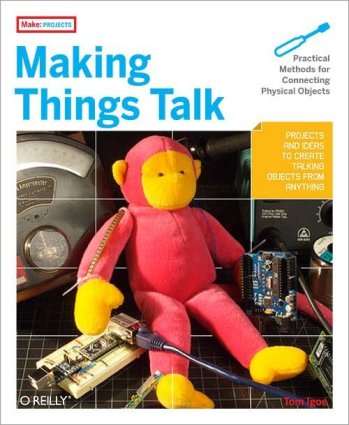 Triage
is a harsh mistress. I started out in computing with the CDP1802,
a microprocessor designed for embedded systems work (it was used
on the Viking Landers!) and for all the software I've used and the
code I've written since then, I miss poking wires in breadboard
holes and hitting the trigger of a wire-wrap gun. There's only so
many hours in a life, and embedded work has not made the cut. Triage
is a harsh mistress. I started out in computing with the CDP1802,
a microprocessor designed for embedded systems work (it was used
on the Viking Landers!) and for all the software I've used and the
code I've written since then, I miss poking wires in breadboard
holes and hitting the trigger of a wire-wrap gun. There's only so
many hours in a life, and embedded work has not made the cut.
That may change. Embedded systems tinkering is easier now. Much
easier, and for a couple of reasons: 1) The processors themselves
can be had on small boards with appropriate I/O connectors; you
don't have to fool with loose chips anymore. 2) Development software
is better, mostly because now there is development software.
In 1976 I literally had to write binary code by hand. (F8 FF A2...
Yes, yes, I know, barefoot and uphill both ways. But if you think
I'm exaggerating, you simply weren't there.) And, the point of the
current discussion, 3) there are books like Making
Things Talk, by Tom Igoe. Wow.
The first time I saw the cover I was confused: It shows a stuffed
monkey and the completely inane blurb, "Projects and ideas
to create talking objects from anything." I literally thought
it was about fooling with speech synthesizers. But no: It's about
networking embedded systems modules with technologies including
Ethernet, USB, Bluetooth, and Zigbee. The microprocessor modules
under discussion are the Atmel AVR-based Arduinos,
augmented by a host of sensor modules and connectivity modules that
can be breadboarded on the same 0.1" spacing blocks we used
to use in 1976. In a sense, we
now have modules the way other people have chips. (And in saying
so I am indeed just boasting.) We can raise our consciousness to
the level of connecting functional blocks rather than individual
inverters and logic gates. That is a very big win.
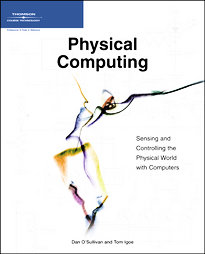 The
book is patient (as good tutorials must be) and begins with probably
the finest introduction to low-level networking that I have ever
seen. If you are a software developer you will understand it; if
you have no experience whatsoever in networking or programming,
you may have some trouble. A good prerequisite text would be Tom
Igoe's 2004 Physical
Computing (written with Dan O'Sullivan) which focuses on
the older Basic Stamp modules and their close relatives. Physical
Computing introduces both electronics and programming to a degree
that Making Things Talk cannot. That said, Making Things
Talk presents examples using a Java-derivative programming environment
called Processing,
which is free and open source and much gentler conceptually than
programming in raw Java or, merciful God help us, C. (Pascal would
be gentler still, but as we all know, Pascal is a kiddie language
that cannot accomplish anything useful. You must believe
this. A C programmer said it. QED.) The
book is patient (as good tutorials must be) and begins with probably
the finest introduction to low-level networking that I have ever
seen. If you are a software developer you will understand it; if
you have no experience whatsoever in networking or programming,
you may have some trouble. A good prerequisite text would be Tom
Igoe's 2004 Physical
Computing (written with Dan O'Sullivan) which focuses on
the older Basic Stamp modules and their close relatives. Physical
Computing introduces both electronics and programming to a degree
that Making Things Talk cannot. That said, Making Things
Talk presents examples using a Java-derivative programming environment
called Processing,
which is free and open source and much gentler conceptually than
programming in raw Java or, merciful God help us, C. (Pascal would
be gentler still, but as we all know, Pascal is a kiddie language
that cannot accomplish anything useful. You must believe
this. A C programmer said it. QED.)
Once the essential groundwork is done, the book teaches through
projects, good projects that are mostly fun and in many cases even
useful. The book explains how RFID tags work and how to read them,
and how to read 2-D barcodes with a Web cam. The most fascinating
projects are those that involve physical location sensing, using
modules that perform infrared ranging, ultrasonic ranging, GPS,
and "digital compass" modules, all of which made the robot
guy within me itch like hell. We didn't have stuff like that thirty
years ago.
Although it doesn't get a huge amount of coverage in the book,
the XBee module (which implements a Zigbee data radio system) fascinates
me: It's basically jelly-bean logic implementing a short-range mesh
network, and I intuit that hobby robots of the future may well consist
of swarms of semi-independent functional blocks knit together coherently
through the Zigbee network protocols, under the control of a multicore
master processor. And damn, I would love to build something like
that.
Anyway. Here are a few additional observations on the book:
- It has at least process color on most pages, with beautifully
shot full-color photos on many of them.
- The technical figures are abundant and very well done.
- The type is very small, the margins narrow. This 425-page book
would have been a 600-page book back in the 90s. My guess is that
O'Reilly wanted to the keep page count down because of all the
costly interior color. Note to my age cohort: Prepare to squint,
or go get yer readers.
- There is far less discussion on debugging than I'd like. Coding
is easy—as is plugging jumper wires into breadboard blocks.
But when something doesn't work the way it should, where do you
start? The book is mostly silent on that crucial point.
- In general, the book probably covers a little too much ground,
and doesn't go for quite enough depth. Zigbee is subtle, and its
subtler features are not explored here. This may not be a completely
fair criticism, but it supports my conviction that you must be
a journeyman embedded systems type to really get the most from
this book, as a lot of the blanks you must fill in yourself.
Don't let any of that stop you: If you have some clue about embedded
systems modules and want to learn embedded systems-level data communications,
there is nothing like this book anywhere. And if I do decide to
go back to embedded systems tinkering, this will be the book that
pushes me over the edge. Not yet—I have a rocket or two to
finish and a few other things to do—but soon, soon.
Highly recommended.

|
 February
19, 2008: Odd Lots February
19, 2008: Odd Lots
- Sorry for the silence here; I rarely go a week without posting
but a lot of things ganged up on me. Many have noticed that I'm
gradually moving toward posting less often but doing longer posts.
I've discovered that it doesn't take me a great deal more time
to write more detailed posts than shorter ones, but not posting
at all on some days allows me to concentrate more fully on other
projects.
- There is a major total lunar eclipse tomorrow night, 2/20-2/21,
which will be almost perfectly positioned for viewing in the US.
See
the NASA page for details. And if you're not up on lunar eclipses
generally, ask Mr.
Eclipse.
- Flash
memory is getting bigger; a 16GB SDHC card would hold a lot
of ebooks.
- Pertinent to the above: I'm not bullish on solid-state drives
based on Flash, especially if they're positioned to replace ordinary
spinning-disk hard drives. Flash storage cells can change state
only so many times until they cease holding a state reliably,
and extra hardware is needed to "spread the wealth around"
so that frequent write activity in a particular location doesn't
kill cells. Flash is thus best used for things like storage of
music and ebook files, where you write data rarely but read it
a lot.
- Also, Flash may evenually be superceded by nonvolatile
phase-change memory. We're still a few years off, but phase-change
is faster than Flash and may even replace volatile RAM. No information
yet that I've found on whether the cells degrade or die after
a certain number of write cycles.
- One other ebook note: Although most early reviewers claimed
that the Kindle's SD slot was limited to 2 GB cards, the truth
is that the card is SDHC and many owners have reported success
with larger cards up to 8 GB. I don't have 8 GB of ebooks yet
and may not for several more years. I just don't read that fast.
For people who are actively converting their print library to
ebooks, however, larger cards are a very important issue.
- This
nice link to NPR came over from Don Doerres, concerning the
growing hobby of watching satellites. We used to go out and freeze
butt looking for Echo in the early 1960s, but these guys are calculating
orbits, photographing flares (momentary bright sunlight glints
off polished satellite parts) and profoundly irritating the spooks.
Watch the videos. Really watch the videos.

|
 February
12, 2008: Odd Lots February
12, 2008: Odd Lots
- Robert Jastrow, the well-known NASA space popularizer, has
left us, at age 82. My copy of Red Giants and White Dwarfs
is in pieces from overuse, but as with Jastrow himself, I can
only say: Mission accomplished.
- I stumbled upon an
interesting piece of art today (while following an unrelated
link sent by Pete Albrecht) by the late
French Impressionist Albert Besnard. Rather too casually entitled
"Decoration for a Ceiling," to me it suggests something
altogether more cosmic: The reunion of all things and all people
with God at the end of time. As Pete suggested for a caption:
"Honey, I picked up your wings from the cleaners." (And
how about using it as a book cover? Right there in the middle
is space for a title!)
- D-Stix are amazingly rare on eBay (considering all the rest
of the bizarre and obscure crap that I see there regularly) but
today I finally scored the 464-piece set from the mid-1960s, and
for only $10 at that. I've mentioned D-Stix here on Contra in
the past, and on our second date, Carol and I flew a tetrahedral
kite that I had made out of D-Stix. Making a replica of that kite
has been on my do-it list for some years now. All I have to do
is find some purple madras tissue paper...
- Jim Strickland sent me a link to a
nice page from a German chap (it's in English) who has done considerable
work with spark speakers. This isn't quite a flame speaker
as I saw one in 1969 (which used an ionized propane torch flame)
but is more like a modulated Tesla coil.
- Also from Jim (in honor of the Westminster Dog Show, which ran
last night) is an
entry from what might as well be LOLDogs. Alas, the bichon
didn't win his group last night. (There are too many poodles in
the world, and not enough melted butter...)
- Still again from Jim is a fascinating short
history of the Teletype.
- While we're talking ancient communication technologies, I finally
remembered to link to a
summary of Western Union's "92 code," which is a
list of 19th century telegrapher's numeric abbreviations that
includes the ''--73--" that has been my email signature since
my MCI Mail days in the early 80s. This is as good a summary as
I've found, but it's missing a few codes that I've heard, like
--86-- which is short for "We are out of..."
- And further in that same direction, here's as
good a list as I've seen of the 10-codes used by CBers, police,
and, of course, Broderick
Crawford.

|
 February
11, 2008: Standard Wall Warts February
11, 2008: Standard Wall Warts
 I
lost the wall wart charger for my Sony Reader a couple of months
ago, and a new one should be here in a few days. I don't love the
Reader, as its USB transfer software unapologetically refuses to
run on Windows 2000, but a guy in my business should have one, just
as he should have a Kindle. In the meantime, I've been thinking
a lot about wall warts, chargers, and one area of electronics that
could really use a standard or two. The high road is something like
the WildCharger featured
recently on Crave, which is basically a pad that induces a trickle
of electricity into whatever you place on it. Wotthell, that technology
should be available built into computer desks, but it's not up to
me. I
lost the wall wart charger for my Sony Reader a couple of months
ago, and a new one should be here in a few days. I don't love the
Reader, as its USB transfer software unapologetically refuses to
run on Windows 2000, but a guy in my business should have one, just
as he should have a Kindle. In the meantime, I've been thinking
a lot about wall warts, chargers, and one area of electronics that
could really use a standard or two. The high road is something like
the WildCharger featured
recently on Crave, which is basically a pad that induces a trickle
of electricity into whatever you place on it. Wotthell, that technology
should be available built into computer desks, but it's not up to
me.
I am very sick of wall warts. I have a bin of them downstairs,
probably thirty in all, and I doubt that any two source the same
voltage. The barrel connectors are of wildly different diameters,
and some of them put the positive conductor on the outside. A few,
furthermore, are not even barrels but weird connectors of no conceivable
justification.
Damn, I want a standard.
Consider this as a possibility: A code for wall warts that could
be printed on both the wart and the electrical device it's shipped
with. The code would be human-readable and contain the essential
parameters:
DC5-20-100-6P
The code begins with AC or DC. (There are AC wall warts, lord knows
why.) The next number is the whole number voltage, separated from
the fractional voltage by a dash. A second dash sets off the current
sourcing capacity in milliamps. The code ends with the diameter
of the barrel connector in millimeters, followed by either an N
or a P, depending on the polarity of the inner conductor. For example,
the code shown above would be for a DC wart sourcing 5.2V at 100
ma, with an 6mm barrel connector having positive on the inside.
There's no reason these things can't be like jelly-bean logic,
and there's no reason why anyone should have to dig too hard or
pay too big for a replacement wart. The IEEE should be doing something
like this, but isn't.
My new Sony Reader charger will show up the day after tomorrow
via DHL. And the day after that, I'm sure I'll find the original.
At least then I'll have a spare.

|
 February
9, 2008: The Revenge of the Classics February
9, 2008: The Revenge of the Classics
I've lived such an overstuffed life for so many years that I'd
almost forgotten a psychology that was a very big part of my youth:
Sniffing around for "just something to read." I'm a very
deliberate reader these days because I don't have a lot of completely
uncommitted time. I have a reading buffer of 50-100 books on hand
here, all of which were chosen because they touch on one of my interests
or another. (My library as a whole contains somewhere around 2500
books, down from 3000 before we left Arizona.) I never have to cast
about at random for just something to read.
For many people, reading is an even bigger part of their lives,
believe it or not. (Maybe fewer than we'd like, but they're out
there.) These people are driving the ebook industry right now, and
I've noticed a phenomenon few others have commented on: the explosion
of interest in out-of-copyright books by people who might not have
been slobbering Dickens or Jane Austen fans in the past. At numerous
sites online, people are uploading ebook versions of many classic
texts. I follow Mobileread,
which now has about
3,800 free ebooks online for download, the bulk of them pre-1923
works, some well-known (they have Dickens'
complete works now) and some pretty obscure, like the Scottish
Psalter of 1650. Mobileread is interesting because people are creating
versions in the popular small-screen ebook reader formats like Ebookwise,
MobiPocket and BBeB rather than raw text—nor formats used primarily
on PCs, like PDF and MS Reader.
I continue to boggle at people reading Thackeray on their cellphones,
but boggle or no boggle, it's being done. The classics are coming
back. I can't entirely explain it, but I have some hunches:
- Many of these ebook editions are beautifully done. The Dickens
canon is the work of one man named Harry in the UK, and they include
some of the nice old 19th Century woodcut illustrations plus color
covers where those were available. (Oliver Twist, yes.
Martin Chuzzlewit, no.) They are not shot full of
OCR errors and gaps like some of the stuff I've downloaded from
other places, including the venerable Project Gutenberg.
- They are free and they are easy to get. There are no hurdles
to jump, nothing to sign up for, no money to lay out, and no DRM
to drop sand in the gears of the experience.
- There are no ethical issues involved in obtaining them or passing
them on. I still think people are basically honest, and they do
consider the rights of copyright holders.
- They're classics because they have withstood the test of time.
They're good.
The classics have always been available in bookstores, of course,
at prices comparable to those of newly published books. But if you're
shopping for something to read on the train going in to work because
it's a dead hour coming and going, it's hard to beat free, especially
if free is easy and involves no pokes from the conscience.
What we're seeing here might as well be called open-source literature.
It's being done by volunteer labor, including people who are drawing
new artwork and contributing it without copyright claims. It's significant
because people writing new ebooks have to take into account that
the total available number of reader-hours in the audience is finite,
and the friction involved in obtaining and reading the classics
is now approaching zero. Like Linux, it will take a while yet for
the well-formatted library of classic ebooks to mature, but like
Linux, they will eventually become a competitive force to reckon
with.
And wow, dare we hope that the premodern will put a fat boot up
the ass of the postmodern? A lot of those "dead white males"
must be grinning about now.

|
 February
7, 2008: Carl and Jerry Volume 5 Is Out! February
7, 2008: Carl and Jerry Volume 5 Is Out!
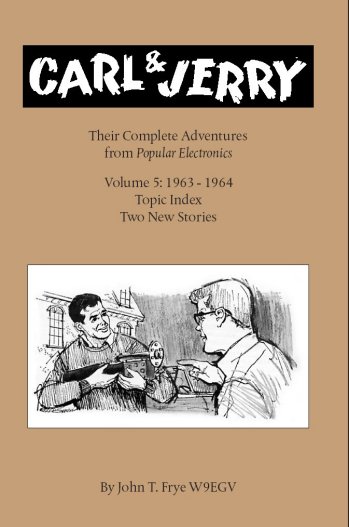 This
one took a lot longer than I had hoped—and certainly longer
than the seething two weeks I spent on Volume 4—but the
fifth and final volume of Carl & Jerry: Their Complete Adventures
is now complete, uploaded, and available on Lulu.com. This has been
my major spare-time project for well over a year, and I scratched
my head now and then as to why it was taking so much time and energy.
Well, here's why: It required 989 pages in five separate books to
print the 263,232 words and 311 illustrations in the 119 stories.
That's a lot of stuff. I mean, a lot. This
one took a lot longer than I had hoped—and certainly longer
than the seething two weeks I spent on Volume 4—but the
fifth and final volume of Carl & Jerry: Their Complete Adventures
is now complete, uploaded, and available on Lulu.com. This has been
my major spare-time project for well over a year, and I scratched
my head now and then as to why it was taking so much time and energy.
Well, here's why: It required 989 pages in five separate books to
print the 263,232 words and 311 illustrations in the 119 stories.
That's a lot of stuff. I mean, a lot.
But it's done. I'm extremely happy with the way it all turned out,
and the fan mail has been very encouraging. The only complaint I've
seen is one chap moaning that, "You mean, there's only 119
stories?" Yup. I wish there were more too; Carl & Jerry
are sui generis. The only thing even remotely similar is
Bertrand Brimley's Mad
Scientists Club, all books of which (fortunately) are still
in print, in nice new editions with all the original Charles Geer
pencil sketches and watercolors. Somewhere further on the fringes
are Tom Swift, Jr and the Danny Dunn books, but the fact remains
that Carl & Jerry were talking about real technology, not Repelatrons
and antigravity paint. Read the stories and you will learn a few
things, albeit things that were first-run between 1954 and 1964.
I added a few things to Volume 5. One is a schematic published
a few months after the story of Carl & Jerry's primordial beambot,
"The Lightning Bug," from a Popular Electronics
reader who built his own Lightning Bug. That's one of my top 5 all-time
favorite Carl & Jerry yarns, and I've posted a
free PDF containing it. It's unusual in that if you want to
build your own, the circuit is right there and ready to go.
One thing that added some time to the task was a topic index that
ran to 19 pages. People have written me to ask, "What was the
Carl & Jerry story where the crook was getting away in an iceboat?"
All they remembered was the iceboat. That's just the way human memory
works; quirky is too kind a word for it. So I went through all 119
stories and built an alphabetical topic index, including any memory
tag I could think of for each story. If you want to look up all
the stories about Carl's dog Bosco, it's there. If you want to know
which story saw the boys build a proton precession magnetometer,
it's there. Skunks figured significantly in two stories, so flip
to "Skunk" and there they are. Ditto Norma, Mr. Gruber,
radio-controlled models, sonar, fishing, smoke signals, Morse code,
car thieves, and on and on. Dare you not to find a story
you remember there.
Finally, I added two new stories, written today in 2008 and not
forty-five years ago. One is by George Ewing WA8WTE, who actually
built the gadget in the story he wrote, way long ago at Michigan
Tech, about the same time that Carl & Jerry were at fictional
Parvoo University. It's basically about building a seismometer from
a broken pinball machine, and it's beautifully done. The other story
is my own, and I borrowed a gimmick from Arthur C. Clarke as way
to explain how reflecting telescopes work. Both are tall tales,
but that's what John T. Frye was offering back in the 60s, and both
stories are authentically tall, done very much in Frye's own style.
And so it's done. Here's the
link to my Lulu storefront where all five books may be purchased.
Many thanks to Michael Covington, for putting the bug in my ear
back in August 2006, and to Pete Albrecht, who taught me how to
un-halftone the illos. (He also did quite a few of them for me.)
Also, thanks to Doug Faunt N6TQS who sent me the last few issues
that I didn't have and somehow just couldn't nail on eBay.
And now it's on to other things. Writing, of course, and putting
together the two collections of my short SF that I've been promising
for years. And FreePascal from Square One. Plenty to do here;
all I need now is the time to do it.

|
 February
6, 2008: Recent Reading February
6, 2008: Recent Reading
I haven't reviewed many books lately, but that isn't because I
haven't been reading. I read quite a bit, if not as much as I often
wish I had time for. If I don't review a book here, it's generally
for one of these reasons:
- Reviewing books is difficult to do well, and my time/energy
is committed to other things;
- The books I read are sometimes so vanishingly narrow in interest
that I doubt anyone would care what I thought of them;
- The books are so-so and I can't bring myself to spend time describing
them.
This third point is the most interesting of the three. A really
bad book I might mention to save you time and money. But what about
a so-so book? Is it worth any effort at all?
This applies to wine as well as books. I try a lot of wine and
like only some of it. The things I like I mention here, especially
if they're unconventional. (Generally this means not dry.) I've
mentioned a few wines that I loathe, like the unfathomably awful
Sweet Walter from the incomprehensible Bully Hill Vineyards in upstate
New York. But something like Taylor Sauterne is difficult to describe,
as it has so little character I'm not sure what to say. It's not
quite tasteless—just mostly tasteless. (It's certainly nothing
like the other sauternes I've had in the past. But then again, it's
an $8 twist-cap wine.)
So today I'm going to mention a few of the books I've read recently,
including the odd things that I expect no one among my readership
to be interested in. I won't spend a lot of space on any of them.
- The Thunderbolt Kid by Bill Bryson. (2006) Probably the
best of the current batch, it is nonetheless extremely
uneven. Gut-splitting hilarious in places, it also has long runs
of very boring stuff, and occasional departures that suggest anger
that the author can't quite express. Misses more than it hits.
Borrow it maybe, and when things get boring, skip to the next
chapter.
- Ghosts and Poltergeists by Herbert Thurston, S. J. (1954,
and now out of copyright) A deadpan description of, well, ghosts
and poltergeists from around the world and across centuries of
time. Competently written but dry; if you want a diverting read
in similar turf, try Colin Wilson's Poltergeist.
- The Polish National Catholic Church by Paul Fox (undated,
probably 1957ish) A self-description of the PNCC for prospective
converts. Nice little book, with some interior color. Includes
church history, its constitution, liturgy, and directory of parishes.
Best concise description of the church at its peak that I've seen.
- Who Really Cares? by Arthur C. Brooks (2007) Reviewing
this book will only get me beaten up, but it reads well and provides
loads of research that I'm not entirely sure I understand the
same way that the author does. His conclusion: Political conservatives
are less selfish than liberals, who are in turn less selfish than
independents. My conclusion: It's down in the noise. Try again,
dood.
- The Fall of the Dynasties by Edmond Taylor. (1963; may
be out of copyright) 300-level European history text that I read
to try and understand WWI. Eye-crossingly dense, but he covers
all the bases and I think I now have a grip on what destroyed
Europe in 1914: Itself. What Europe is best at. Surprise!
- Huck's Raft: A History of American Childhood by Steven
Mintz. (2004) Almost worth a review, and not a total waste of
time, but the author describes more than he explains, and I put
the book down having gained a great deal of information but not
a lot of insight.
- Every Knee Shall Bow: The Case for Christian Universalism
by Thomas Allin and Mark T. Chamberlain. (2005) Covers ground
well-covered in other books on this topic, and doesn't add much
that I haven't seen. Confines itself to scriptural argument, and
doesn't go after more gnarly philosophical questions like, How
can eternal punishment for finite transgression be just?
- Original Blessing by Matthew Fox. (1983) A muddy-headed
challenge to the Augustinian heresy that changed original sin
to original guilt. Fox makes me nuts sometimes, but here and there
he goes places nobody else wants to go. He's willing to condemn
Augustine of Hippo, something no one else (except me) is willing
to do. I honestly don't know what to think about this book, which
will be incomprehensible to anyone without a fair grounding in
Christian theology.
- Complexification by John L. Casti. (1994) Awful, but
not so awful I wanted to waste the energy required to throw it
at the wall. Maybe a smarter guy could grasp what's there. Or
maybe there's nothing there to grasp. Pass.
Note also that I cruise a lot of computer books, but I haven't
sat down to read one cover-to-cover in years. I haven't mentioned
any of those here, good or bad. I also occasionally pull out books
I've already read and reread a few chapters to clarify some question
that's been haunting my mind. I haven't mentioned those here either,
but that's actually a growing slice of my reading time, and an interesting
phenomenon all by itself that I should take up again at some point.
That will have to do for now. I know I've read a few other things
in the last couple of months, but they made such a light impression
I don't recall what they were, which says something right there.

|
 February
3, 2008: Puppies, Not Pigskins February
3, 2008: Puppies, Not Pigskins

I dislike sports generally, though I watch baseball on occasion
in honor of my Cubs fan father. Football always seemed ridiculous
to me somehow and hockey—well, it's the spawn of the devil.
So we're not watching the Super Bowl today. (We have gone to Super
Bowl parties on occasion for the sake of the company, and we stop
to watch only when the commercials come on.) We have the Puppy
Bowl on right now, and George Ewing tells me that WE has a Cutest
Puppy Pageant scheduled as well, but as we don't get WE here it's
hard to tell.
This is the fourth year that Animal Planet has done the Puppy Bowl,
and acccording
to Wikipedia it consistently has the highest ratings of anything
programmed opposite the Super Bowl. I consider it a work of utter
brilliance: For several hours, a rotation of five or six puppies
(out of a total "slate" of about twenty) just mix it up
in a little set painted to look like a football stadium. They wrestle,
haul toys around, and slop in their water bowl. Every so often one
of them takes a crap, after which a human extra in a referee's outfit
steps in to clean it up.
We left the Puppy Bowl on for QBit while Carol and I took Aero
and went over to visit Jimi Henton—on roads that were basically
empty. Jimi is the bichon groomer and breeder from whom we purchased
Aero. Aero enjoys some Puppy Bowl action with Jimi's several bichons,
most of them his close relatives. (QBit is unrelated and doesn't
enjoy them as much.) We enjoy them too; I could never have that
many dogs, but every now and then it's fun having a pile of four
or five bichons on your lap.
Jimi has only one puppy at the moment, who arrived as a litter
of one the day after Christmas. We snapped some shots this afternoon,
and that's him up above. He's five and a half weeks old, and completely
beautiful. His nose is darkening up nicely (bichon noses are pink
at birth but become totally black after a few months) and he's not
as manic as a lot of puppies his age are. He's destined to be a
good size for a bichon, simply because he got all the nutrition
while gestating, but he also looks to be show quality and a real
heart-stealer. Jimi will be selling him once he's eight weeks old,
so if you're looking for a great bichon puppy—and especially
if you want to show him—contact
Jimi at her Web site.
Right now I'm going back to the kitchen to put some supper together
while watching the Puppy Bowl. Football? What's that again? Oh,
right. Pass.

|
 February
2, 2008: Banging Our Shins February
2, 2008: Banging Our Shins
Groundhog Day. Snowing like hell here, and not only didn't our
groundhog see his shadow, he couldn't even get out of his burrow.
Nor did we get out of ours: Carol and I slept in and spent part
of the afternoon watching...Groundhog Day.
I was going to write a longish essay on what may be the finest
film of the past fifty years, but I realized that someone
else had already written it. Basically, What He Said.
To be human is to learn better, no matter how much it hurts. Some
catch on faster than others, and while it's clear that a lot of
people die before they learn much of anything at all, I'm not going
to be so arrogant as to claim confident knowledge that death is
the end of all learning. Maybe we're only beginning. Of course it's
better to learn sooner than later—but if the alternative is
to keep banging our shins on things without end, I'm guessing that
even the worst of us will eventually figure it out.
That's the message of Groundhog Day: You repeat Sixth Grade
until you learn the lessons. Then it's on to Seventh Grade. (I'm
good with that. You can have Eternal Rest. Give me Eternal Challenge!)

|
|
